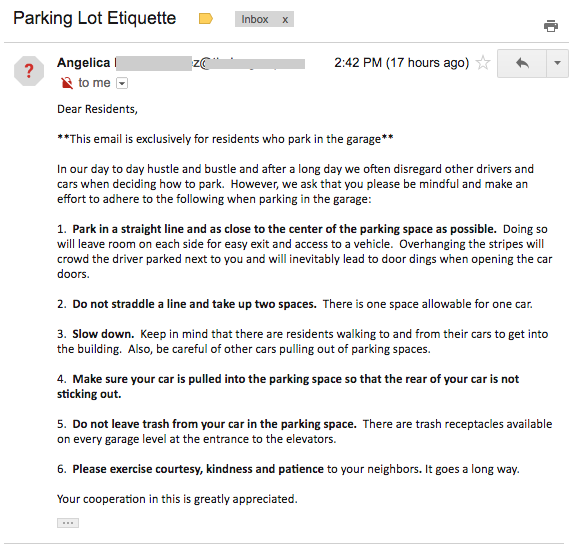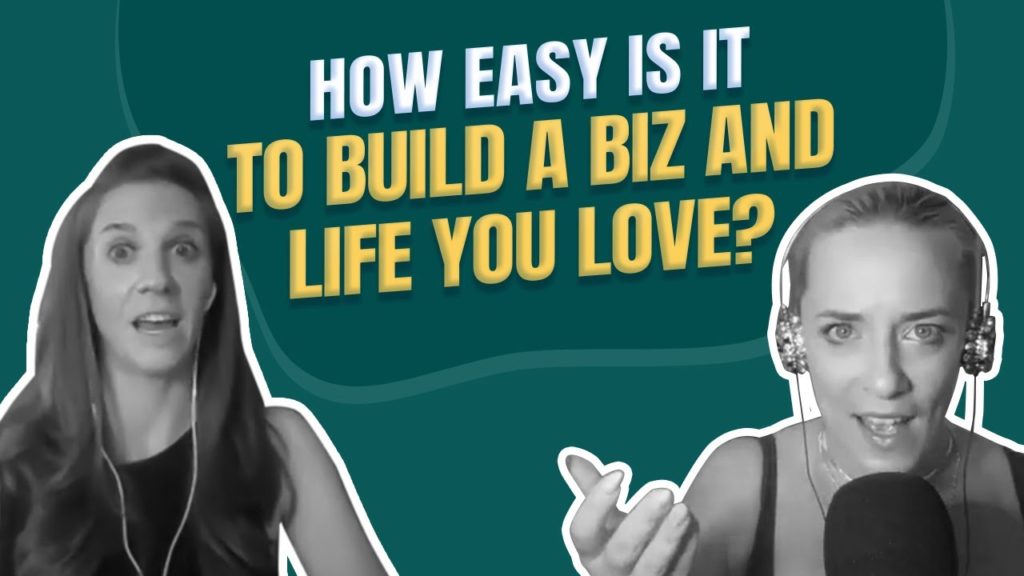There’s a lotta talk about copy being the “be all end all” to behavior change. And while it matters, it’s not actually the thing that moves the needle.
Exhibit A. This email from a property manager to her residents.
Technically, this emails follows all the copy rules.
- Language is clear, not clever
- Doesn’t break the left margin
- Highlights main points in bold
- Makes appropriate use of bullets
- Well-spaced and doesn’t overwhelm you with large blocks of text
If this email was being graded on “following the rules” it would get an A. But the mistake this property manager made was not in the copy. The mistake is in the underlying assumptions behind the words.
(In other words: the strategy)
Believe it or not, there’s more to behavior change than *just* copy (I know, it hurts me to write it as much as it hurts you to read it). Here’s the truth:
You can follow all the rules and still see no results.
The goal of this email was (presumably) to reduce parking lot infractions. Which means the question the email should have addressed was, “How do you get people to stop parking like assholes?”
Instead, it answered a different question. It answered: “How should people park properly in this lot?”
“Park in a straight line and as close to the center of the parking space as possible.”
While that is the best little piece of comic relief I’ve read in a while, it’s not exactly useful.
“Do not…take up two spaces”
No shit, Sherlock.
The property manager spends the entire email delivering on the wrong goal. She is telling the residents how they should park. It’s the wrong problem.
The problem isn’t that people don’t know how to park. It’s that they aren’t doing it.
You can assume that someone who is taking up two spaces knows that’s not how you park. Telling them not to park that way is like telling someone who robbed a bank not to rob the bank.
He already knows not to do it. Shaming him for it isn’t going to help you reach your goal (remember: it always comes back to the goal. The goal is not “perfect well-written copy.” The goal is a reduction in parking infractions).
You have to get to the core of why the behavior you want to change is happening in the first place.
The manager here assumes that people are parking like assholes because they don’t know how to park properly (which is what the email addresses – it’s a list of how to park properly in a parking lot, aptly titled “Parking Lot Etiquette”).
That’s not why people park like assholes.
Let’s break this down by going to the human level: Someone taking up two spaces is parking that way because someone probably pinged his car once and this is a reasonable (albeit, douchey) way to avoid getting pinged by a door again. Or he’s just a douche who thinks his car is better than yours. Either way, there’s only one goal in exhibiting that kind of douchey behavior: to separate himself from the rest of the cars.
So, you now know that his goal is to separate himself (physically). And your goal is to get him to park like a decent human. Now we have to bridge that gap. That’s what your strategy has to address. Your strategy has to bridge the gap.
How do you get him not to do that?
You don’t need to point out the specific infraction. You need to go to the consequence.
The appropriate strategy is to highlight the consequences for bad behavior.
And this is where words and action collide. You use language to create a threat (or the perception of one) and then you use behavior (actual consequences) to deliver on that threat.
Here’s how I’d rewrite this email effectively:
Dear Residents Who Park in the Garage,
If you park like an asshole, we will tow your car.
You’ve been warned.
Sincerely,
Management
You could make a few edits to make this SFW. But the point is the threat the words carry needs to be real. Other consequences could be feeing residents, putting boots on their wheels, or revoking parking privileges.
Words are ineffectual at creating behavior change if they’re empty threats or deliver on the wrong thing. In this case, the email successfully communicated that management is angry at you, but will likely not do anything.
Which is exactly what’s happened. I took a stroll through this garage 2 months after this email was sent. Nothing had changed. Perfect copy failed to deliver.
Because copy isn’t just about the words. It’s about understanding people.
Like right now I understand you’d like to get on with your day and stop reading this article (though, I’m very grateful you’ve come this far). So I’ll let you go.





